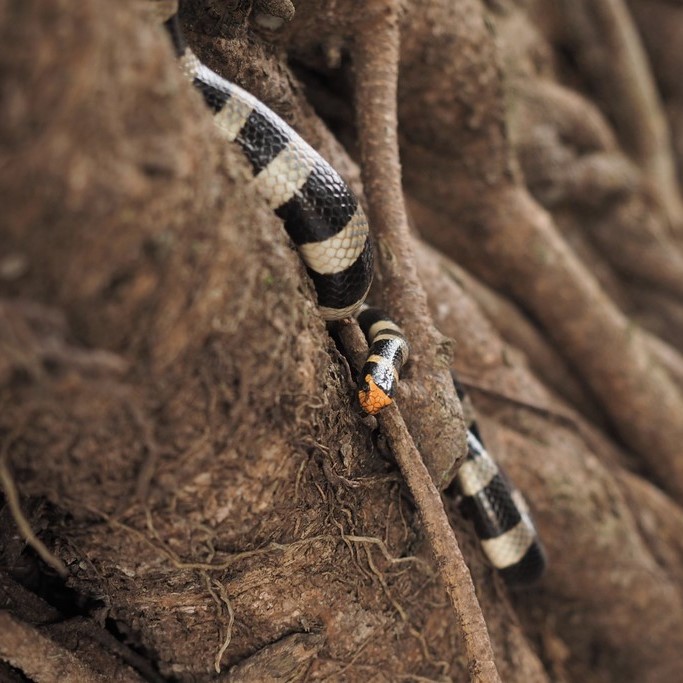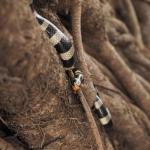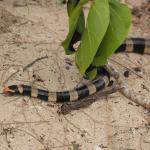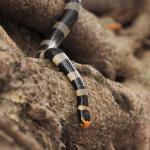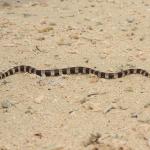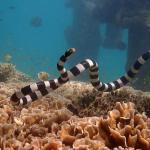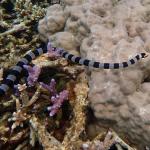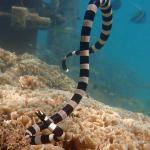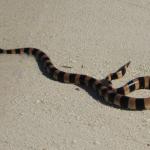- Home
- Herpetofauna Index
- Native
- Laticauda Saintgironsi
Laticauda saintgironsi
New Caledonian sea krait
Laticauda saintgironsi
(Cogger & Heatwole, 2006)
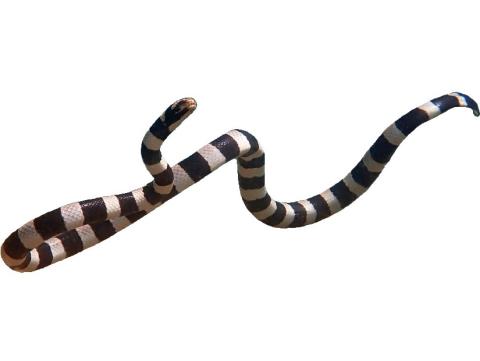
Length: Females can reach lengths of up to 1.35m; males are significantly smaller rarely exceeding 0.9m.
Weight: In adults between 0.25 and 0.7kg, with the males being lighter than the females.
Description
A distinctive species of marine snake, often exhibiting brown and black banding, and that has to date only been observed once in Aotearoa's waters. As with our other marine snakes, they are often sick/beach-wrecked when found, and being highly venomous should be reported to DOC so that appropriate actions can be taken for both human and the animal's safety.
They are visually similar to both the yellow and brown-lipped sea kraits, although they can typically be differentiated from these species based on colouration. The New Caledonian sea krait often exhibits light brown/fawn to orange banding, as opposed to the grey or steel blue tones of the other species.
In lighter coloured individuals the distinction is less clear, and other characters may need to be used. In this case, they can be differentiated from the brown-lipped sea krait by the presence of a yellow upper lip as opposed to the brown upper lip of that species, as well as fewer black bands (25-39 vs. 35-54). They can be differentiated from the yellow-lipped sea krait by a combination of size (being smaller), and the tendency for their dark body banding to not meet on the ventral surface.
They can be easily differentiated from the yellow-bellied sea snake by general morphology (blunt vs. flattened elongate head) and patterning (banded vs. striped).
Life Expectancy
Not known.
Distribution
The New Caledonian sea krait is restricted to the waters around New Caledonia, and the Loyalty Islands.
An extremely rare visitor to New Zealand, this species is only known from a single individual.
Ecology and Habitat
A semi-aquatic species, the New Caledonian sea krait as with other Laticauda species spends a significant amount of time on land where it has been known to travel to elevations greater than 100 metres asl. They are often associated with the shallow waters surrounding islands, and coral reefs where they can be seen hunting for prey at night. However, they have been reported as diving to depths of up to 60 metres when hunting in deeper waters. When on land they typically shift between basking sites and refugia (rock crevices, complex tree root structures, tree cavities, seabird burrows, and various ground debris), and are known to be good climbers. Females tend to spend more time on land than males, although this is likely associated with reproductive factors.
Social Structure
This species is typically solitary, although they can be found in large aggregations (100 or more) in refuge sites.
Breeding Biology
The New Caledonian sea krait does not breed in New Zealand.
They are oviparous (egg-laying), with females (minimum of 75cm SVL) depositing clutches of between 1-8 eggs into sheltered crevices in the littoral zone from December to February. The young hatch out at around 35cm SVL, and 14 grams, after an incubation of approximately 4½ months. Sexual maturity is reached at 1 ½-2 ½ years old.
Diet
Primarily an eel specialist, with about 50% of their diet being attributed to one species, the lipspot moray eel (Gymnothorax chilospilus), although they may on rare occasions prey upon other small fish species.
Most foraging excursions take place within a few kilometres of their home islands, with this species preferentially focussing on prey living within the crevices of hard-bottomed habitats (coral, rubble, and rocky coastlines), however, they have been recorded making excursions as far as 38km from their home island.
Disease
The New Caledonian sea krait hosts several reptilian diseases and parasites including the sea snake tick (Amblyomma nitidum).
Conservation status
Listed as a vagrant (species outside its normal range) in the most recent threat classification for New Zealand reptiles, and as Least Concern under the IUCN criteria.
Interesting notes
Named for the late Dr Hubert Saint-Girons (1926-2001) - one of the most esteemed herpetologists to come from France - who published many papers and had a life-long interest in snakes.
The New Caledonian sea krait was at one time considered to sit within the yellow-lipped sea krait species complex, but was elevated to full species status, after the discovery of high site fidelity within the group (thus little genetic drift), as well as several features that clearly separated it from the former species.
Although highly venomous, they are non-aggressive, and thus it is extremely rare for envenomation to occur. Bites only occur when the animal is accidentally grabbed, and the animal bites in self-defence, as is the case when the animal is being removed from fishing nets.
It is possible that on occasion several of the sea krait species arrive in New Zealand on board private boats, as the animals have a tendency to climb into small spaces such as water intakes and exhaust pipes.
References
Ineich, I. (2006). The sea snakes of New Caledonia (Elapidae, Hydrophiinae), pp359-366.
van Winkel, D., Baling, M., & Hitchmough, R. (2018). Reptiles and Amphibians of New Zealand: A Field Guide. Auckland University Press, pp376.

